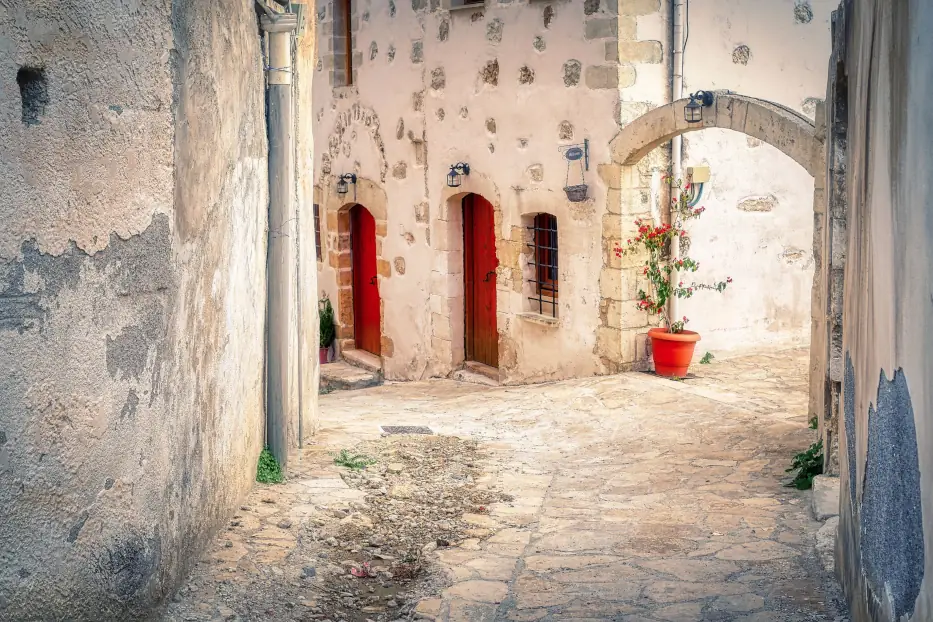Nestled in the embrace of the Mediterranean Sea, Crete is a land of contrasts. It is Greece’s largest island, where rugged mountains meet the shimmering blue of the sea, where ancient myths still echo through grand palaces, and where a rich cultural tapestry has been woven over thousands of years.
Crete is not just an island; it is a world unto itself, offering a breathtaking mix of history, nature, and culinary excellence.
Table of Contents
Geography & Nature
Spanning approximately 260 kilometers (160 miles) from east to west and up to 60 kilometers (37 miles) from north to south, the largest island in Greece boasts a varied topography that includes majestic mountain ranges, fertile plateaus, and a coastline stretching over 1,000 kilometers (650 miles). The island’s highest peak, Mount Ida (Psiloritis), rises to 2,456 meters (8,058 feet), offering panoramic vistas and a haven for hikers.
The White Mountains (Lefka Ori) in the west feature over 30 summits exceeding 2,000 meters (6,562 feet), with the renowned Samaria Gorge cutting through the range. This 16-kilometer-(10-mile)-long gorge, a designated World Biosphere Reserve, presents a challenging yet rewarding trek through sheer rock faces and diverse flora.
Crete’s coastline is a tapestry of sandy beaches, secluded coves, and dramatic cliffs. The palm-fringed shores of Vai, the pink sands of Elafonissi, and the turquoise waters of Balos Lagoon are just a few of the island’s coastal gems.
Inland, the landscape transforms into rolling hills adorned with olive groves, vineyards, and aromatic herbs, reflecting the island’s agricultural heritage.
The Five Largest Greek Islands
| Rank | Island | Area (km²) | Area (sq mi) | Location |
|---|---|---|---|---|
| 1 | Crete | 8,336 | 3,219 | Southern Aegean Sea |
| 2 | Euboea | 3,684 | 1,422 | Eastern Greece |
| 3 | Lesbos | 1,633 | 631 | Northeastern Aegean |
| 4 | Rhodes | 1,401 | 541 | Southeastern Aegean |
| 5 | Chios | 842 | 325 | Eastern Aegean Sea |
History
As the cradle of the Minoan civilization, Europe’s earliest advanced society, Crete’s historical significance is profound. The Minoans, flourishing around 3,000 to 1,100 BC, left behind architectural marvels such as the Palace of Knossos near Heraklion.
This sprawling complex, associated with the legendary King Minos and the myth of the Minotaur’s labyrinth, offers insights into a sophisticated culture renowned for its art and commerce. Throughout its history, Crete has been a coveted prize, falling under Roman, Byzantine, Venetian, and Ottoman rule.
Each era has imprinted its legacy, evident in the island’s diverse architecture, fortified castles, and historic monasteries. The Venetian influence is particularly prominent in cities like Chania and Rethymno, where narrow alleys, ornate facades, and bustling harbors evoke a bygone era.
Best Things to Do on Crete
How to Get to Greece’s Largest Island
Crete is well-connected by both air and sea. The island has three airports: Heraklion International Airport, Chania International Airport, and a smaller facility in Sitia. Direct flights connect Crete to Athens and major European cities.
For those who prefer sea travel, ferries run from Piraeus, the port of Athens, to Heraklion, Chania, and other coastal towns. Overnight ferries provide a leisurely and scenic journey to the island.
When to Visit Crete
The largest island in Greece enjoys a Mediterranean climate with warm, dry summers and mild, wet winters. The best times to visit are from April to June and September to October when temperatures are pleasant, the landscapes are lush, and crowds are thinner.
Spring brings wildflowers in full bloom, while autumn offers warm seas and the flavors of the grape harvest. Summer is ideal for beach lovers, though temperatures can soar above 30°C (86°F). Winter, though cooler, is still mild compared to much of Europe, and an excellent time to explore the island without the tourist rush.

Why Visit the Largest Island in Greece
Crete is a microcosm of Greece’s finest offerings. It is a land where history and mythology come to life, where nature astounds at every turn, and where traditions are celebrated with warmth and passion.
Whether you are an adventurer seeking rugged landscapes, a history buff exploring ancient ruins, or a traveler longing for sun-drenched beaches and exquisite cuisine, Crete welcomes you with open arms. More than just a destination, Crete is an experience that stays with you long after you leave its shores.
From the aroma of olive groves to the echo of the lyra in a mountain village, the spirit of Crete is as enduring as the land itself. To visit Crete—the largest island in Greece and the fifth largest in the Mediterranean Sea, after Sicily, Sardinia, Cyprus, and Corsica is to step into a world of wonder, where every moment is a discovery and every path leads to a new adventure.
